Gender Gap Within College Tiers and Parental Income
We examined the mean parental incomes of both male and female students within each college tier and compared them to trends that we hypothesized. Before making the graph, we hypothesized that students at higher-tiered colleges would have a greater mean parental income than students at lower-tiered schools for both genders. In addition, we expected to see females with a greater mean parental income than males because there were generally more females enrolled in colleges than males in recent decades.

In the graph, the blue bars represents the average female parental income and the orange bars represent the average male parental income for each college tier. The data was right skewed and from this, we were able to observe one major trend that followed our original predictions. The students at ivy plus schools had the highest mean parental incomes for both genders, with the average female mean parental income at $412,212 and the average male parental income at $450,376. The mean parental incomes declined as you moved down the college tiers. Students at two-year (public and private not-for-profit), four-year for-profit, and two-year for-profit had the lowest mean parental incomes for both genders, with females having a mean parental income of $58,156 and males $70,848 at two-year for-profit schools.
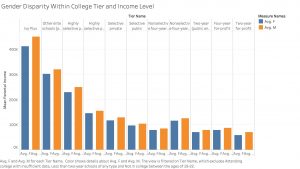
One thing that we did find surprising was that across the board, males had a greater average parental income than female students within every college tier. This was something that we did not expect to see because there are a number of surveys and data released by universities about their male to female ratio on campus, where there are typically more female students enrolled than male students. As a result, we anticipated that the mean parental income for female students would be greater than males because there were generally a greater proportion of female students at colleges. This was not the case. The mean parental incomes of male students exceeded those of female students, with the greatest difference seen in ivy plus students.

There are many factors that contribute to these results. Some being the difference between public and private universities and the persistent gender pay gap and family structure at these schools. Students who come from single parent households will have a lower mean parental income than students who come from two-parent households where both parents are contributing to the mean parental income. In addition, students raised by with single-mothers or have absentee fathers may have a lower mean parental income due to factors, such as a gender pay gap or a decrease in college enrollment, particularly among males. There are many factors that contribute to these findings, and therefore, we cannot point to one particular reason for as the basis of our conclusions. However, we explore some of these issues further within our topic.
We also decided to peak inside the major stratification between these two genders. During the career and college search process, whether as a parent or student, there perhaps may be a strongly considered perspective with scope. Payscale actually performed an analysis on gender and major selection. The conclusion determined that women chose majors that led them to a lower salary than the national median average.
According to that same Payscale post, “The percentage of men and women who chose Engineering and Education as their major in response to the American Association of University Women’s (AAUW) study of the gender pay gap. They found Engineering (median pay of $75,000/year) to be male dominated, while Education (median pay of $42,000/year) is dominated by female majors. Therefore, differences in major choice can greatly affect the national pay gap.


In an updated research project, we determined 15 common majors for men, 15 common majors for women and 15 common majors with roughly equal numbers of men and women graduates. Similar to AAUW, we find women tend to major in various Design/Art majors, Education, Nursing, and Public Relations, while men tend to major in Engineering, Finance, Computer Science, and Economics. Majors common to both include Accounting, Journalism, Biology, History, English and Mathematics.”


Widening Gender Gap for Higher Education Attainment
Across the board, Americans are more likely to graduate from high school, enroll in college, and obtain degrees than they were in the past. However, if we take a closer look, more women are now attending college than ever before and are outpacing men in college enrollment and graduation rates. According to Dr. Vedder, director of the Center for College Affordability and Productivity and professor at Ohio University, there are only 3 men for every 4 women that graduate from four-year colleges. There would be approximately 14% more college graduates each year, and over 2 million in over a decade, if men and women graduated from college in the same proportions. This gender gap is apparent across all ethnicities; however, it is more notable among blacks and Hispanics, where women graduates greatly outnumber men.
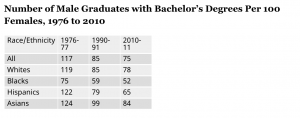
Since the Census Bureau started to collect information on higher education attainment, women are now more likely to obtain a bachelor’s degree than men. In 2015, 30.2% of women had a bachelor’s degree while 29.9% of men did. In 2005, only 26% of women had bachelor’s degree while 28.5% of men did. The reason for this increase is due to a rise in young women pursuing higher education. In females between the ages of 25-34, 37.5% of women have a bachelor’s degree or higher, whereas only 29.5% of men do. However, for people over the age of 65, only 20.3% of women compared to 30.6% of men have bachelor degrees or higher. This shift in gender indicates that as times are changing, more women than men are obtaining bachelor degrees.

Many have looked into factors that could have contributed to this growing gender disparity and concluded that gender and family-structure and socioeconomic status differences may have impacted the widening gender gap. According to a study by William Doherty, Brian Willoughby, and Jason Wilde, changes in family structures have led to the growing gender gap in higher education attainment. Both genders of children that grew up with stably married parents were equally likely to succeed at school, However, the absence of a father seemed to lead to less boys obtaining a college education. The researchers obtained longitudinal data on more than 15,000 people who were in 7th to 12th grade in the 1994-1995 school year from Add Health. The results illustrated that out of the participants whose fathers were present, 63.1% of men and 72.1% of women had some college education. From those who had an absent father, 49.2% of men and 61.3% of women had some college education. In addition, socioeconomic status can play a role in the increasing gender gap. As stated by Dr. Vedder, people who have had the most contact with the welfare state through public assistance policies, have also seen a decrease in males obtaining a college education. From these observations, it is likely that family structure and socioeconomic status impacts the widening gender disparity in higher education attainment. Other aspects that would be interesting to look at further would be to see the gender ratios at public and private universities and across different states.
Income Differences Within Elite Colleges
Putting the notion of gender differences aside, it’s important and worthwhile to acknowledge why elite institutions attract so many students from higher incomes in the first place, and why, regardless of their goals to attract global communities, they tend to fail to admit large numbers of low-income students into their student bodies.
In 2014, Yale alumnae Robin Hayes wrote an article in The Atlantic titled, “Why Ivy League Schools Are So Bad At Economic Diversity.” It was essentially a response and criticism of the article that Yale Alumni Magazine published a month prior titled “Wanted: smart students from poor families.” Yale’s explicit outreach to its wealthy Alumni base served as their announcement that their goal is to “seek smart students from poor families,” as the author describes these low-income students as “out there – but hard to find.” In her article, Hayes states that the author unknowingly reveals how the privileged trustees, alumni and administrators at Yale show the obstacles as to how this goal of attracting poor students will never come true.
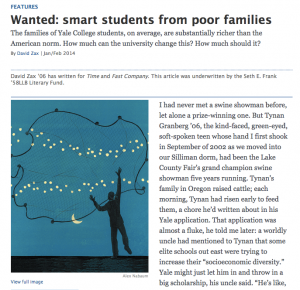
Yale defines their high-achieving student body as having “high GPAs in ‘demanding’ high schools and extraordinary character-defining extracurricular activities.” The high-income students that typically make up the Yale student body come from affluent feeder schools that have curriculums which include small classrooms, teach critical thinking skills, leadership qualities and that encourage participation; these students come from high schools where they had access to athletics, creative activities, well-resourced libraries, and heavily connected college counselors. However, the students that Yale says it is trying to attract more are the students who can’t afford to attend those affluent, higher-income schools and therefore many of them deal with harsh conditions like gun violence, overcrowding, and a curriculum that emphasizes obedience over excelling. It is the students that achieve academically in these poor public schools despite their difficult surroundings that are rarely seen as high achievers by top schools such as Yale; as Hayes states, “The collegiate honor roll lacrosse captain easily surpasses the Benjamin Banneker high B+ student who lives in a shelter and works at Target after school to help out her single mother and younger siblings.”
Just as Yale’s perception of the high achieving student is cockeyed, so too is their definition of a low-income family. The alumni magazine article notes that 69% of the freshmen at that time were from families with annual incomes higher than $120,000 in a country where the median household income is $52,700, and the international median household income is $10,000. Perhaps if Yale re-evaluated what a low-income versus a high-income student was, their goal of reaching more students who don’t come from the wealthiest high schools will be met. Hayes also suggests in her conclusion that the elite colleges are overvaluing the quality of the students from higher income families and undervaluing lower-income applicants.
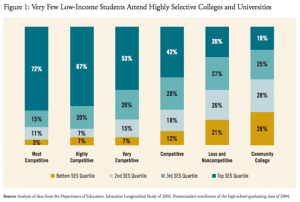
Although Yale is only one example of an elite university, it serves as a microcosm for the phenomenon of the top colleges and universities who have contributed to the well-known trend of rich kids attending the best schools in America. In delving into the Equality of Opportunity project, and specifically in income-differences within varying leveled institutions, it’s important to look at the possible reasons behind why there is an income difference at these elite colleges and universities.
Future Trends
In terms of future trends, a Pew Research Center analysis of U.S. Census Bureau data research has shown a clear progression of females attending colleges more than men. In 1994, 63% of females were enrolled into college opposed to 61% of males. By year 2012, the female enrollment increased to 71%, an 8% increase; whereas, for males the percentage remained at 61%.
Breaking it down by different races, we can also see a future trend of females outpacing men. The data was shown as follows:
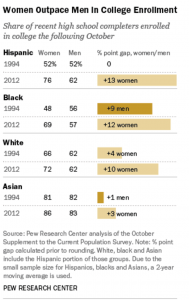
For Hispanics, in 1994, among Hispanics who completed high school, both men and females were at 52% enrollment. Fast forward to 2012, both did increase, but females outpaced men by 14 percentage points. Females: 76%, Males 62%
For African Americans, it was a little different story in 1994. Young black men were more likely than black females to attend college. 56% male, 48 % female. However, the same pattern seems to come to be when 2012 hits. Black males percentage only increased by 1 percent to 57%, opposed to females that increased a whopping 21% to 69%.
For Asian Americans, the percentage from 1994 to 2012 still portrays females outpacing men. In 2012, 86% of females attend colleges, whereas 83% are male.
Looking at this data, one can realize that the future of females attending college over men seems to be trending upward. Why is that the case? According to many scholars, they have contributed this widening gender gap due to the labor market barriers being lowered for women, which has led to the benefits of a college education. Others have cited behavioral changes and more males are becoming more inclined to be involved in crime.
In conclusion, as time continues to go by we might see more females applying to colleges than males.
 ]]>
]]> ]]>
]]>
 ]]>
]]>